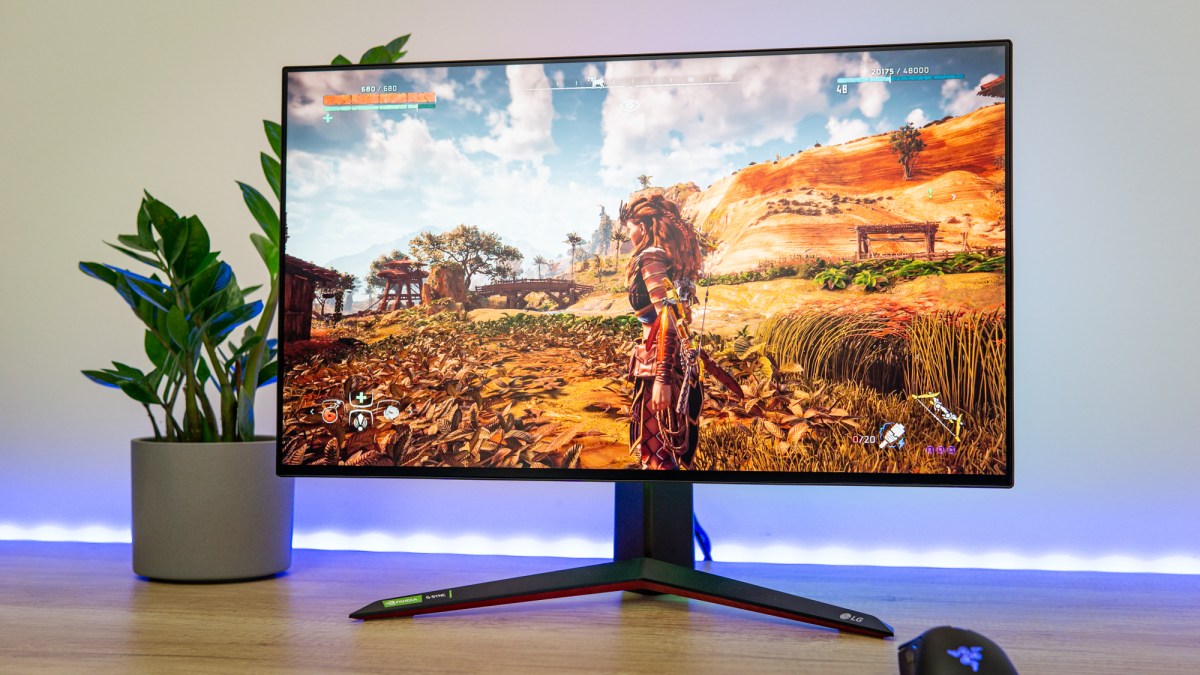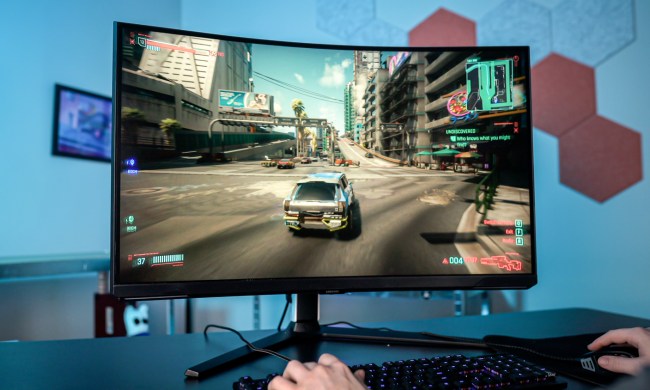- Extremely good image quality
- Superbly fast gaming performance
- Intuitive, sharp and responsive OSD
- Classy looks
- Easily access I/O
- No HDMI 2.1
- Unimpressive stand
If you’re one of the lucky few that managed to get your hands on one of the latest graphics cards, you’ll also need a killer 4K gaming monitor to match it.
But even the best monitors have a tough time offering both great image quality and a high refresh rate. LG’s new 4K gaming monitor, the 27GN950, claims to do just that. Using Nano-IPS screen technology, it just might be as close as you’ll get to perfection without jumping all the way up to an OLED TV.
Design

Being a 27-inch monitor, the first thing that will stand out about the 27GN950 is that it isn’t very big. Among the massive ultrawide monitors and 32-inch 4K behemoths, this 27-inch panel is a breath of fresh air as its focus is purely on a crisp image.
The bezels around the panel are hair-thin, with the bottom one a little thicker than the rest. There is no LG logo to be found on the front of the panel, and without a curve, it looks surprisingly elegant — if you omit the somewhat garish stand.

Around the rear of the monitor, you’ll notice that the display’s enclosure isn’t made from the fanciest materials. It’s just cheap, scratchy plastics. Fortunately, it’s at the back, so you won’t be troubled by it too often.
Around the mount and input/output island is a big RGB ring, which lights up with the monitor and can adjust its colors to what’s on display — it’s a neat party trick to increase immersion despite the modest panel size.

Then there’s the display’s stand, which I’m not a fan of. The adjustment mechanism has all the height, tilt, and rotate adjustments you’ll need. But with a panel that looks as elegant as this, I feel the stand itself is a bit too aggressively styled. It’s like a throwback to an older generation of gaming gear, but it’s not one I’m nostalgic for.
The front feet connect to the main pillar in an odd fashion, and I wish LG had kept its logo off for a cleaner aesthetic. If you’re a minimalist like me, though, I’d ditch the stand and use a monitor arm. There are VESA 100 mounting holes are present to assist with this.
Ports and controls

If you’re a pure PC gamer, the 27GN950’s rear input/output panel will serve you well. It comes with one DisplayPort 1.4a port that supports DSC (Display Stream Compression) in order to deliver full 4K, 160Hz, 4:4:4 RGB support when using an RTX 20-series GPU or newer.
If you’re someone who also has a console placed next to your PC to get access to Sony’s exclusives, you may feel a bit let down for one simple reason: The absence of HDMI 2.1. Indeed, with the Playstation 5 and Xbox Series X promising 120Hz 4K gameplay over HDMI 2.1, it seems a bit odd that LG opted to install only an HDMI 2.0 controller despite the majority of its latest TVs supporting HDMI 2.1. This means the maximum refresh rate supported by the 27GN950 over the HDMI ports is a measly 60 Hz. At least there are two HDMI ports here, so you can plug in two consoles if you’re OK with the refresh rate compromise.
Other than that, there is a two-port USB hub and a headphone jack, and the monitor is powered by a 110-watt external power brick that’s thin and easy to hide under your desk.
The immediate access to brightness controls is extremely valuable.
LG’s on-screen display (OSD) control panel is in a league of its own. The interface is controlled through a single directional toggle at the bottom of the display, and it’s extremely crisp, responsive, and easy to navigate. To control the display’s brightness, you simply push the toggle forward or backward to jump straight into the brightness controls. To control volume for the headphones, just toggle left or right to lower or raise the volume.
The OSD is also easy to navigate. It has five main submenus that include Game Mode with a few presets and Game Adjust with advanced options such as Adaptive-Sync, a Black stabilizer for boosting dark-level detail, and a cheating crosshair. The Picture Adjust menu gives options for adjusting brightness, contrast, sharpness, and color settings. Finally, there is an Inputs submenu and one called General System.

The only complaint I have about the OSD is that seemingly doesn’t render in a high resolution. The 4K panel is capable of displaying extremely sharp and crisp images, so it’s a little weird that the OSD is rendered a little fuzzy, though it’s not like you’ll spend a ton of time here anyway, and it’s still better than most.
Image quality
LG’s Nano IPS-based gaming monitors stand out with the image quality they provide, and the 27GN950 is no exception. The company promises that the 27GN950 covers 98% of the DCI-P3 space, and while our unit didn’t quite hit that figure, it wasn’t far off with a tested value of 96%. Our sample covered 100% of the sRGB space and 88% of AdobeRGB.
We also tested the monitor’s color accuracy, which resulted in an average Delta-E value (difference from real) of just 0.69. Consider that anything below a Delta-E of 2 is generally accepted as good enough for professional work, and you’ll probably agree that the 27GN950 is superbly well-suited to creative graphic work, which isn’t something we often see on gaming monitors.
Where the display falters, however, is in contrast performance. The fast Nano IPS panel is great for quick responses, high refresh rates, a wide color gamut, and accurate colors, but one of IPS’ weaknesses is weak contrast performance. Our sample achieved a figure of 980:1 at full brightness, which is pretty much identical to the promised 1000:1 ratio on the spec sheet. If you’re someone who likes to play games at night and don’t need the wide gamut and color accuracy, you may prefer to opt for a cheaper VA panel.
The 27GN950 is superbly well-suited to graphic work — which isn’t something we see often on gaming monitors.
The peak brightness we achieved on the 27GN950 was an eye-burning 462 nits, which is more than plenty for most use cases, including brightly-lit rooms, and more than promised on the spec sheet. Gamma performance was also perfect out of the box, and the 6900K white point is pretty close to the 6500K target, though this can easily be corrected with OSD settings or calibration.
After calibrating the monitor, I was able to pull 1% more DCI-P3 coverage out of it, correct the white point, and increase the color accuracy from 0.69 to just 0.63. While these are improvements, it’s safe to say that there’s little to gain from calibrating the 27GN950 and most users needn’t bother.
Gaming performance

When it comes to gaming on the LG 27GN950, there’s one thing you need to be aware of before taking the plunge: This display requires a serious amount of GPU horsepower if you want to run modern titles at the full 4K resolution and make use of the high refresh rate.
For older games, this won’t be as much of an issue, but today’s AAA titles, especially those with ray tracing, will be heavy to push. You’ll need at least a GeForce RTX 3070 or Radeon RX 6800 XT if you want smooth performance, and even with those cards, you won’t be nearing the top end of the panel’s 144Hz refresh rate when running the games at maximum settings.
But that’s not a flaw of the monitor itself. When it comes to panel performance, the 27GN950 puts on an impressive show. The Nano IPS panel is extremely responsive, and after updating the display’s firmware, easily overclockable to 160 Hz with just the press of a button. Stuttering and tearing is handled by FreeSync Premium Pro and G-Sync compatibility, and the display has low frame rate compensation for the inevitable dips with modern titles.
Unlike VA panels, the Nano IPS panel here doesn’t smear.
The smallish form factor of 27 inches also lends itself well to competitive gameplay as it allows you to keep all of the game within view. It’s also a great monitor for those who like to get up close during intense gameplay thanks to the sharp image.
Unlike VA panels, the Nano IPS panel here doesn’t smear either. Budget high-refresh rate monitors often come with VA panels, and though they offer better contrast ratios, they can produce noticeable color smearing, especially in dark scenes. The 27GN950 doesn’t suffer from any such flaw.
However, what really makes the 27GN950 special is the combination of this stellar gaming performance with the sharpness of 4K, and the extremely wide color palette offered by the 96% DCI-P3 coverage.

I played a fair amount of Horizon Zero Dawn on this panel, and this game makes excellent use of its wide gamut. The way it portrays the sun’s colors, intense red sunsets, vivid greens for the foliage, and deep blues for the water, along with the sharp image … it was something to behold.
The trade-off is that it’s not as immersive as something like the LG 34GN850 Curved Ultrawide with the same Nano-IPS technology, but not everyone wants a huge, ultrawide monitor on their desk.
What to expect from HDR600
The 27GN950 also comes with HDR600 support, which means it can produce up to 600 nits peak brightness when using just one of the HDR zones. It comes with 16 edge-lit dimming zones, which is alright but not great. It’s certainly no OLED panel, and VA panels tend to do a better job at producing deep black levels.
Of course, if you want a true HDR experience on a gaming monitor, you need to find one with FALD (Full Array Local Dimming) lighting, but this array of LEDs behind the panel instead of edge lighting costs a lot of money. Think two grand lots of money.
Personally, I enjoy playing most with HDR turned off. It’s nice to play around with what the 27GN950 can offer, but the cleanest image is produced with it off. Besides, Windows looks very flushed out with HDR on, and you’re required to turn it on in Windows to be able to enable it in your game settings.
Our take
If you’re in the market for a 4K monitor for both gaming and creative work, the LG 27GN950 is, at this moment in time, pretty much your only option. If offers a responsive panel with up to a 160Hz refresh rate, all while maintaining a wide color gamut and extremely good color accuracy out of the box, which isn’t a combination we see very often. It’s also one of the first 4K gaming monitors to use DSC.
The main drawbacks are its contrast performance, an unimpressive stand, and the distinct lack of HDMI 2.1, which is a strange omission considering LG has been including it on its OLED TVs since 2019. This makes the panel mostly suited to PC use, as the next-gen consoles won’t have enough bandwidth to push into high frame rates.
Are there any alternatives?
At this time, the only two viable alternatives are the Asus XG27UQ and the Acer Nitro XV273K, which both come in slightly cheaper. However, they’re not overclockable to 160 Hz, and instead limited to 144 Hz, and their overall look is a little tackier. Other than the stand, the LG 27GN950 looks simple, clean, and refined.
How long will it last?
Although the IPS technology is showing its age with the low contrast ratio, the 4K 160 Hz panel means this monitor should last you quite a while, as it will take a few more years before GPUs are able to saturate its refresh rate.
The monitor should last as long as most monitors: a minimum of 5 years. LG only covers it with a 1-year warranty, though.
Should I buy it?
Yes, if you need a monitor for both work and play, and it has to be 4K, the LG 27GN950 is a great option to consider.





